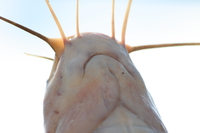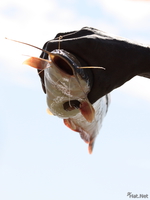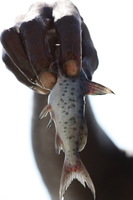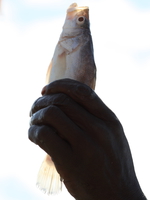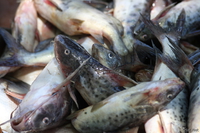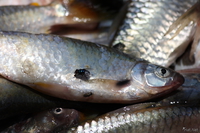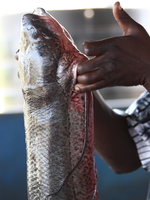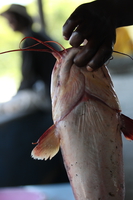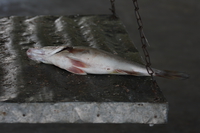lake fish
A large number of species of catfishes have been named from complete or partial skeletal fossils or even from only otoliths. 19 valid genera and 72 species are based exclusively on fossil remains. There are two fossil families, Andinichthyidae, from the Lower Maastrichtian to Paleocene, as well as Hypsidoridae, from the Middle Eocene.
The earliest known catfish are known from the late Campanian-early Maastrichtian of Argentina. Catfish fossils are known from every continent except Australia. Fossils of the Eocene period have been found from Seymour Island in Antarctica. The order dispersed early throughout the continents primarily through land bridges. Australian species of catfish are all species from families that can enter saltwater; these fish traveled to Australia through saltwater, and then reverted to a freshwater lifestyle.
Catfish (order Siluriformes) are a very diverse group of bony fish. Named for their prominent barbels, which give the image of cat-like whiskers, catfish range in size and behavior from the heaviest, the Mekong giant catfish in Southeast Asia and the longest, the wels catfish of Eurasia, to detritivores (species that eat dead material on the bottom), and even to a tiny parasitic species commonly called the candiru, Vandellia cirrhosa. There are armour-plated types and also naked types, neither having scales. Despite their common name, not all catfish have prominent barbels; what defines a fish as being in the order Siluriformes are in fact certain features of the skull and swimbladder. Catfish are of considerable commercial importance; many of the larger species are farmed or fished for food, and some are exploited for sport fishing, including a kind known as noodling. Many of the smaller species, particularly the genus Corydoras, are important in the aquarium hobby.
Lungfish are freshwater fish belonging to the order Dipnoi. Lungfish are best-known for retaining characteristics primitive within the Osteichthyes, including the ability to breathe air, and structures primitive within Sarcopterygii, including the presence of lobed fins with a well-developed internal skeleton. Today, they live only in Africa, South America, and Australia. While vicariance would suggest this represents an ancient distribution limited to the Mesozoic supercontinent Gondwana, the fossil record suggests that advanced lungfish had a cosmopolitan freshwater distribution and that the current distribution of modern lungfish species reflects extinction of many lineages following the breakup of Pangea, Gondwana, and Laurasia.
The catfishes are a monophyletic group. This is supported by molecular evidence.
Catfish belong to a superorder called the Ostariophysi, which also includes the Cypriniformes, Characiformes, Gonorynchiformes and Gymnotiformes, a superorder characterized by the Weberian apparatus. Some place Gymnotiformes as a sub-order of Siluriformes, however this is not as widely accepted. Currently, the Siluriformes are said to be the sister group to the Gymnotiformes, though this has been debated due to more recent molecular evidence. As of 2007 there are about 36 extant catfish families, and about 3,023 extant species have been described. This makes the catfish order the second or third most diverse vertebrate order; in fact, 1 out of every 20 vertebrate species is a catfish.
The taxonomy of catfishes is quickly changing. In a 2007 paper, Horabagrus, Phreatobius, and Conorhynchos were not classified under any current catfish families. There is disagreement on the family status of certain groups; for example, Nelson (2006) lists Auchenoglanididae and Heteropneustidae as separate families, while the All Catfish Species Inventory (ACSI) includes them under other families. Also, FishBase and the Integrated Taxonomic Information System lists Parakysidae as a separate family, while this group is included under Akysidae by both Nelson (2006) and ACSI. Many sources do not list the recently revised family Anchariidae. The family Horabagridae, including Horabagrus, Pseudeutropius, and Platytropius, is also not shown by some authors but presented by others as a true group. Thus, the actual number of families differs between authors. The species count is in constant flux due to taxonomic work as well as description of new species. On the other hand, our understanding of catfishes should increase in the next few years due to work by the ACSI.
The rate of description of new catfishes is at an all-time high. Between 2003 and 2005, over 100 species have been named, a rate three times faster than that of the past century. In June, 2005, researchers named the newest family of catfish, Lacantuniidae, only the third new family of fish distinguished in the last 70 years (others being the coelacanth in 1938 and the megamouth shark in 1983). The new species in Lacantuniidae, Lacantunia enigmatica, was found in the Lacantun river in Chiapas, Mexico.
The larger tilapias are generally not viewed as good community aquarium fish because they eat plants and tend to be very disruptive, digging up the substrate and fighting with other fish. The smaller west African species, such as Tilapia joka, and those species from the crater lakes of Cameroon are, by contrast, relatively popular. Conversely, in cichlid aquariums tilapias can be mixed well with non-territorial cichlids, armoured catfish, tinfoil barbs, garpike, and other robust but peaceful fish. Some species, including Tilapia buttikoferi, Tilapia rendalli, Tilapia joka, and the brackish-water Sarotherodon melanotheron melanotheron, are attractively patterned and decorative fish.


